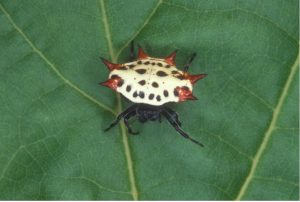As an extension agent in SW Florida, I frequently receive inquiries about spiders in the lanai. The covered outdoor porches here are both ubiquitous and a favored environment for several spider species. There are ~58 spider species in Florida (5 of these are venomous). Spiders making their home inside of your lanai are hoping to capture small insects such as flies. Although spiders are often regarded as unwanted visitors, we need them terribly — an average spider eats 2,000 other insects a year, including many nuisance pests that attack both food crops and ornamentals. Due to the immense pest control services that spiders provide, scientists have conjectured that a world without spiders is a world of famine for humans and other animals.
Most spiders are small, shy, and best left alone, however control tactics can be employed to remove these year-round visitors. If a spider or a web in a lanai is bothering you, you can vacuum it right up! After vacuuming, remove the vacuum bag and place in a sealed bag for disposal.

Routine cleaning is the most important strategy for keeping spiders at bay. Before reaching for a can of insecticides, try these preventative steps:
- Vacuum your carpets and floors regularly, including under furniture and inside cabinets.
- Remove webs when you spot them
- Seal entrypoint gaps under doors and between screens with weather stripping.
- Clear clutter such as wood piles and stacks of boxes. Spiders will shelter in undisturbed, darkened cracks.
- Deter other insects, such as flies that spiders eat, by keeping your kitchen clean and free of trash.
- Keep your home and lanai dry and ventilated – some spiders are attracted to moisture.
If a spider problem still exists after routine cleaning, you can utilize spot treatment applications of insecticides containing pyrethrins or pyrethroids. Apply to locations where you see spiders routinely building webs. Make sure not to agitate spiders so that they do not drop down on you – this is especially important if you are removing a venomous species.
For more details on spider chemical control, see
https://edis.ifas.ufl.edu/publication/MG206
For more details on the spiders found in our area, see
https://edis.ifas.ufl.edu/publication/IN017
For details about my favorite Florida spider, the Spiny Orb Weaver (Gasteracantha cancriformis), see
https://edis.ifas.ufl.edu/publication/IN324
*This article was inspired by and adapted from a fact sheet originally written by Doug Caldwell, P.hD., extension agent emeritus. Hamutahl Cohen, Ph.D., is a commercial horticulture extension agent and landscape entomologist with the University of Florida, Collier County Extension Service. The Cooperative Extension Service is a branch of the University of Florida, Institute for Food and Agricultural Sciences and a department of the Public Services Division of Collier County Government. E-mail Hamutahl.cohen@ufl.edu.
 1
1
